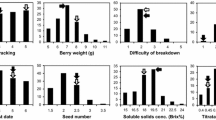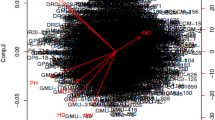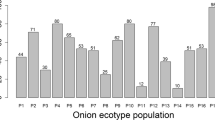Abstract
The main objective of this research was the evaluation of the variability present in a segregating wine grape population derived from a cross between Graciano × Tempranillo, two Spanish varieties, in order to select improved genotypes with potential for producing high-quality wines in a climate change scenario. For that purpose, the phenotypic segregation of 16 agronomic traits related to production and phenology and 11 enological traits related to technical and phenolic maturity was studied in the progeny for three consecutive years. All traits presented transgressive segregation and continuous variation. Year effect was significant for all traits except total, extractable and skin anthocyanins content. However, a high level of genotype consistency for enological traits was revealed by repeatabilities and correlations between years. Significant correlations among traits were observed but most associations were weak. Furthermore, the CAPS (Cleaved Amplified Polymorphic Sequence) marker for the VvmybA genotype was tested to determine whether it would be useful in indirect selection for berry anthocyanins content. The results showed that the number of homozygous and heterozygous genotypes for the functional colour allele adjusted to a 1:1 segregation ratio, and that homozygous genotypes had significantly higher anthocyanins content. Principal component analysis found eight variables that contributed up to 80 % of the phenotypic variability present in the population. Seven groups of hybrids were distinguished based on ripening time, cluster weight, berry weight and anthocyanins content by cluster analysis; and fourteen genotypes were pre-selected for further research.






Similar content being viewed by others
References
Alleweldt G, Possingham JV (1988) Progress in grapevine breeding. Theor Appl Genet 75:69–673
Baggiolini M (1952) Les stades repères dans le développement annuel de la vigne et leur utilisation pratique. Rev Rom Agric Vitic 8:4–6
Bayo-Canha M, Fernández-Fernández JI, Martínez-Cutillas A, Ruiz-García L (2012) Phenotypic segregation and relationships of agronomic traits in Monastrell × Syrah wine grape progeny. Euphytica 186:393–407
Bergqvist J, Dokoozlian N, Ebisuda N (2001) Sunlight exposure and temperature effects on berry growth and composition of Cabernet Sauvignon and Grenache in the central San Joaquin Valley of California. Am J Enol Viticult 52:1–7
Bowers JE, Dangl GS, Vignani R, Meredith CP (1996) Isolation and characterization of the new polymorphic simple sequence repeat loci in grape (Vitis vinifera L.). Genome 45:1142–1149
Bowers JE, Dangl GS, Meredith CP (1999) Development and characterization of additional microsatellite DNA markers for grape. Am J Enol Viticult 50:243–246
Buttrose MS, Hale CR, Kliewer WM (1971) Effect of temperature on the composition of ‘Cabernet-Sauvignon’ berries. Am J Enol Viticult 22:71–75
Cacho J, Fernández P, Ferreira V, Castells JE (1992) Evolution of five anthocyanidin-3-glucosides in the skin of the Tempranillo, Moristel, and Garnacha grape varieties and influence of climatological variables. Am J Enol Viticult 43:244–248
Chomé P, Sotés V, Benayas F, Cayuela M, Hernández M, Sáenz F, Ortiz J, Rodríguez I, Chaves J (2006) Variedades de Vid Registro de Variedades Comerciales. MAPA, Madrid
Clark JR (2010) Eastern United States table grape breeding. J Am Pomol Soc 64:72–77
Cleland EE, Chuine I, Menzel A, Mooney HA, Schwartz MD (2007) Shifting plant phenology in response to global change. Trends Ecol Evol 22:357–365
Coombe BG, Hale CR (1973) The hormone content of ripening grape berries and the effect of growth substance treatments. Plant Physiol 51:629–634
Coombe BG, Iland PG (2004) Grape berry development and winegrape quality. In: Dry PR, Coombe BG (eds) Viticulture volume 1-resources. Winetitles, Adelaide, pp 210–248
Costantini L, Battilana J, Lamaj F, Fanizza G, Grando MS (2008) Berry and phenology-related traits in grapevine (Vitis vinifera L.): from quantitative trait loci to underlying genes. BMC Plant Biol 8:38
Doligez A, Bouquet A, Danglot Y, Lahogue F, Riaz S, Meredith CP, Edwards KJ, This P (2002) Genetic mapping of grapevine (Vitis vinifera L.) applied to the detection of QTLs for seedlessness and berry weight. Theor Appl Genet 105:780–795
Downey MO, Dokoozlian NK, Krstic MP (2006) Cultural practice and environmental impacts on the flavonoid composition of grapes and wine: a review of recent research. Am J Enol Viticult 57:257–268
Duchêne E, Schneider C (2005) Grapevine and climatic changes: a glance at the situation in Alsace. Agron Sustain Dev 25:93–99
Falconer DS (1989) Introduction to quantitative genetics, 3rd edn. Longman Scientific and Technical, London
Fanizza G, Lamaj F, Costantini L, Chaabane R, Grando MS (2005) QTL analysis for fruit yield components in table grapes (Vitis vinifera). Theor Appl Genet 111:658–664
Fraga H, Malheiro AC, Moutinho-Pereira J, Santos JA (2013) Future scenarios for viticultural zoning in Europe: ensemble projections and uncertainties. Int J Biometeorol 57:1–17
Gladstones JS (2004) Climate and Australian viticulture. In: Dry PR, Coombe BG (eds) Viticulture volume 1-resources. Winetitles, Adelaide, pp 90–118
Gonzalez-San Jose ML, Santa-Maria G, Diez C (1990) Anthocyanins as parameters for differentiating wines by grape variety, wine-growing region, and wine-making methods. J Food Compost Anal 3:54–66
Hall A, Jones GV (2009) Effect of potential atmospheric warming on temperature-based indices describing Australian winegrape growing conditions. Aust J Grape Wine R 15:97–119
Harbertson JF, Kennedy JA, Adams DO (2002) Tannin in skins and seeds of Cabernet Sauvignon, Syrah, and Pinot noir during ripening. Am J Enol Viticult 53:54–59
Ibáñez J, Muñoz-Organero G, Zinelabidine LH, Teresa de Andrés M, Cabello F, Martínez-Zapater JM (2012) Genetic origin of the grapevine cultivar Tempranillo. Am J Enol Viticult 63:549–553
Jackson DI, Lombard PB (1993) Environmental and management practices affecting grape composition and wine quality-a review. Am J Enol Viticult 44:409–430
Jones GV, Davis RE (2000) Climate influences on grapevine phenology, grape composition, and wine production and quality for Bordeaux, France. Am J Enol Viticult 51:249–261
Jones GV, White MA, Cooper OR, Storchmann K (2005) Climate change and global wine quality. Clim Change 73:319–343
Jordao AM, Ricardo da Silva JM, Laureano O (1998) Evolution of anthocyanins during grape maturation of two varieties (Vitis vinifera L.) Castelao Francés and Touriga Francesa. Vitis 37:93–94
Kliewer WM (1977) Influence of temperature, solar radiation and nitrogen on coloration and composition of Emperor grapes. Am J Enol Viticult 28:96–103
Lai R, Woolley DJ, Lawes GS (1989) Retardation of fruit growth of kiwifruit (Actinidia deliciosa) by leaves: interactions with vine performance and seed number. Scientia Hort 39:319–329
Liang Z, Yang C, Yang J, Wu B, Wang L, Cheng J, Li S (2009) Inheritance of anthocyanins in berries of Vitis vinifera grapes. Euphytica 167:113–125
Liang Z, Sang M, Ma A, Zhao S, Zhong GY, Li S (2011) Inheritance of sugar and acid contents in the ripe berries of a tetraploid × diploid grape cross population. Euphytica 182:251–259
Liang Z, Sang M, Wu BH, Ma A, Zhao S, Zhong GY, Li S (2012) Inheritance of anthocyanin content in the ripe berries of a tetraploid × diploid grape cross population. Euphytica 186:343–356
Liu H-F, Wu BH, Fan PG, Xu HY, Li SH (2007) Inheritance of sugars and acids in berries of grape (Vitis vinifera L.). Euphytica 153:99–107
Martín JP, Borrego J, Cabello F, Ortiz JM (2003) Characterisation of Spanish grapevine cultivar diversity using sequenced-tagged microsatellite site markers. Genome 46:10–18
Mullins MG, Bouquet A, Williams LE (1992) Biology of grapevine. Cambridge University Press, Cambridge
Nadal M (2010) Phenolic maturity in red grapes. In: Delrot S, Medrano H, Etti O, Bavaresco L, Grando S (eds) Methodologies and results in grapevine research. Springer Science, Heidelberg, pp 389–411
Nadal M, Lampreave M (2007) Influencia del riego en la maduración polifenólica de las bayas y la calidad de los vinos. Experiencia del riego en la comarca del Priorato, DO Montsant. In: Fundamentos, aplicación y consecuencias del riego en la vid. Editorial Agrícola Española, Madrid, pp 231–256
Núñez V, Monagas M, Gomez-Cordovés MC, Bartolomé B (2004) Vitis vinifera L. cv. Graciano grapes characterized by its anthocyanin profile. Postharvest Biol Technol 31:69–79
Ortega-Regules A, Romero-Cascales I, López-Roca JM, Ros-García JM, Gómez-Plaza E (2006) Anthocyanin fingerprint of grapes: environmental and genetic variations. J Sci Food Agric 86:1460–1467
Ramos MC, Jones GV, Martínez-Casasnovas JA (2008) Structure and trends in climate parameters affecting winegrape production in northeast Spain. Clim Res 381:1–15
Riaz S, Dangl GS, Edwards KJ, Meredith CP (2004) A microsatellitemarker based framework linkage map of Vitis vinifera L. Theor Appl Genet 108:864–872
Saint-Criq de Gaujelac N, Vivas N, Glories Y (1998) Maturité phénolique: définition et contrôle. Rev Franc Oenol 173:22–25
Sefc KM, Regner F, Turetschek E, Glössl J, Steinkellner H (1999) Identification of microsatellite sequences in Vitis riparia and their applicability for genotyping of different Vitis species. Genome 42:367–373
Shiraishi M, Fujishima H, Chijiwa H, Muramoto K (2011) Estimates of genotypic and yearly variations on fruit quality and functional traits for tetraploid table grape breeding. Euphytica 185:243–251
This P, Lacomb T, Thomas M (2006) Historical origins and genetic diversity of wine grapes. Trends Genet 22:511–519
Thomas MR, Scott NS (1993) Microsatellite repeats in grapevine reveal DNA polymorphisms when analysed as sequence-tagged sites (STSs). Theor Appl Genet 86:985–990
Van Leeuwen C, Seguin G (2006) The concept of terroir in viticulture. J Wine Res 17:1–10
Viana AP, Riaz S, Walker MA (2011a) Evaluation of genetic dissimilarity in a segregating wine grape population. Genet Mol Res 10:3847–3855
Viana AP, Riaz S, Walker MA (2011b) Evaluating genetic diversity and optimizing parental selections in a segregating table-grape population. Am J Enol Vitic 62(3):285–290
Vivas de Gaulejac N, Nonier MF, Guerra C, Vivas N (2001) Anthocyanin in grape skins during maturation of Vitis vinifera L. cv. Cabernet Sauvignon and Merlot noir from Bordeaux terroirs. J Int Sci Vigne Vin 35:149–156
Walker A, Lee E, Bogs J, McDavid DAJ, Thomas MR, Robinson SP (2007) White grapes arose through the mutation of two similar and adjacent regulatory genes. Plant J 49:772–785
Webb LB, Whetton PH, Barlow EWR (2006) Potential impacts of projected greenhouse gas-induced climate change on Australian viticulture. Aust N Z Wine Ind J 21:16–20
Webb LB, Whetton PH, Barlow EWR (2007) Modelled impact of future climate change on the phenology of winegrapes in Australia. Aust J Grape Wine R 13:165–175
Wei X, Sykes SR, Clingeleffer PR (2002) An investigation to estimate genetic parameters in CSIRO’s table grape breeding program. 2. Quality characteristics. Euphytica 128:343–351
Acknowledgments
This research was funded by the Government of La Rioja through the FOMENTA 04/2008 research project. Shiren Song was initially supported by a fellowship from the Chinese Research Council and for the last 3 years by a MAE-AECID fellowship from the Spanish Government. We thank the collaboration of Aleceia Bermejo, Elena López-Ocón and Ana Mangado for laboratory work.
Author information
Authors and Affiliations
Corresponding author
Rights and permissions
About this article
Cite this article
Song, S., del Mar Hernández, M., Provedo, I. et al. Segregation and associations of enological and agronomic traits in Graciano × Tempranillo wine grape progeny (Vitis vinifera L.). Euphytica 195, 259–277 (2014). https://doi.org/10.1007/s10681-013-0994-z
Received:
Accepted:
Published:
Issue Date:
DOI: https://doi.org/10.1007/s10681-013-0994-z




